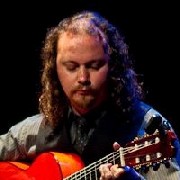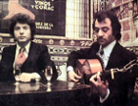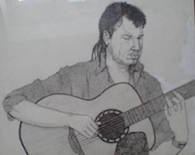Welcome to one of the most active flamenco sites on the Internet. Guests can read most posts but if you want to participate click here to register.
This site is dedicated to the memory of Paco de Lucía, Ron Mitchell, Guy Williams, Linda Elvira, Philip John Lee, Craig Eros, Ben Woods, David Serva and Tom Blackshear who went ahead of us.
We receive 12,200 visitors a month from 200 countries and 1.7 million page impressions a year. To advertise on this site please contact us.
|

|
|
Chord question
|
You are logged in as Guest
|
|
Users viewing this topic: none
|
|
Login  | |
|

   
Ricardo
Posts: 14833
Joined: Dec. 14 2004
From: Washington DC

|
 RE: Chord question (in reply to Pimientito) RE: Chord question (in reply to Pimientito)
|
|
|
You need to understand that a scale and a 13 chord are the same thing so you have to realize how the notes in a chord are stacked up in thirds. To have a proper chord you need a root, 3rd, and some kind of other note, either 5th, 7th, 9th, 11th, or 13th. (because when stacking intervals we can't use 2,4,6 of the scale, those occur when building chords as "extensions", 9,11,13).
So to find the root, stack the notes and discover which is the strongest. the 5th can be missing, but not the ROOT or the 3rd (unless you have a bass instrument playing the root but lets assume you don't).
AGCF#C....so ignore the extra C for now. AGCF#....the only 3rd relations are A-C and F#-A. So since A is the bass start with A as the root: ACG (1,b3,b7) which is an Am7 chord (minus the 5th which is almost always ok). The F# note would be the #6th as you would have in a Dorian scale. But the chord we build as 1-3-5-7-9-11-13. So it is Am7-13...and the 7 is redundant or implied so you name it simply Am13. And you have the scale implied as well....A dorian.
If I tried to spell the chord with the other third relation.....F#-A...we have a not so strong chord structure:F#-A-C-G....1,b3,b5,b9....so F#m(7)b5b9/A.....a much too complicated name for an inverted Am13, the implied scale is F# locrian (relative of A dorian or G major and B phrygian....a clue to possible flamenco palo). Lower common denominator is usually the way to go, but CONTEXT could change things.
Ricardo
_____________________________
CD's and transcriptions available here:
www.ricardomarlow.com
|
|
|
|
REPORT THIS POST AS INAPPROPRIATE |
Date Jan. 2 2011 14:18:41
 |
|

   
Ricardo
Posts: 14833
Joined: Dec. 14 2004
From: Washington DC

|
 RE: Chord question (in reply to Guest) RE: Chord question (in reply to Guest)
|
|
|
quote:
By using this shape and their ear, new harmonies (thanks to Paco and others) began to emerge.
Hey romerito! I know you hate me when I contradict you, but.....
The melodic minor scale conflicts with that chord voicing cuz of the G#vs G natural. True Paco uses that scale but deliberately avoids voicing the G# in any of his chord forms when such a scale is his intent.
D Double harmonic is often things I have seen Paco and others do as you tabbed, and fits better that chord voicing as it has that G#....but the name of the scale is not what I have heard used. For me D double harmonic (minor)would have a Bb not B natural, so 12b3#45b67.....The scale you wrote I have heard called A harmonic major-12345b67....based on the 5th mode in this case. Jazz guys may think mixolydian flat 6 but I have not heard that term persay. And as the Rico kiko said, E6(b9) is the simple way to write it. If we did voice a D note (7th) then it is fine to call it E13(b9) too.
I agree with Estevan, in Context of flamenco sometimes it is silly to describe all extensions etc as if it is jazz harmony function. The extensions could be incidental because of voicing, Left hand technique or barre chord, or open string even. I have often stated using this terminology for flamenco is not really appropriate....yet I felt compelled to answer Pimientito's question as it was on the face. What is a "proper" name for the chord and how I came up with that.
quote:
But really the notes present in that chord are the notes of C# maj.(inversion)
even though C# may not be the root. Like C#/E
meaning C#Major over an E bass.
Not really. You have the 7th, the B note. So C#7/E....but also you have E again in the high voice, so C#7#9/E.....in jazz and rock etc we know the proper voicing for such a chord is not as tabbed out...so the tab actually gives us a better context so we come up with a better name I think (E6b9 as discussed). I do agree sometimes when chords move with a pedal bass note, it is good to use that slash method to be clear.
quote:
---3--------
---3--------
---4---------
---5---------
---0---------
---5---------
is Gmaj/A (G major over A bass) although it is funtioning as an A chord , meaning that it will resolve after this to D maj (V,I) rather than being a G chord resolving to C ,
Easier one I am used to seeing is A11....but I would have played the top E string open in the voicing. G/A is fine for me but it need not go to D maj necessarily. More often this just goes to A7...and THEN to D. So functioning more like a IV chord usually with the 5th as a pedal.
Ricardo
_____________________________
CD's and transcriptions available here:
www.ricardomarlow.com
|
|
|
|
REPORT THIS POST AS INAPPROPRIATE |
Date Jan. 4 2011 20:57:51
 |
|

   
Ricardo
Posts: 14833
Joined: Dec. 14 2004
From: Washington DC

|
 RE: Chord question (in reply to El Kiko) RE: Chord question (in reply to El Kiko)
|
|
|
quote:
In jazz tabs are never used it would be written like that if the voicing is not so important otherwise you'd be reading it on manuscript as is so often the case.
Also I would be playing many chords that do not have roots or 5ths as in the jazz combo , piano or bass would have them so I wouldn't double up
a typical II-V-I in F maj might be
---5-------------5------------5------------------------
---6-------------5------------5----------------------
---7-------------7------------5---------------------
---8-------------8------------7-------------------
---x--------------x------------8-------------------
---x--------------x------------x--------------------
the first chord are the extension of a Gmin chord and the seconed chord C7 even though there are no roots , this is the context I mean , and its minimal finger movement ( but thats cos I'm Lazy)
Totally with you...groovy man. But most of the questions about chords on here will be applying to flamenco, not jazz...so it can be assumed we don't have a bass player playing roots and 5ths to keep it clear. Anyway I would still better name your chords, even in jazz context, with bass included on G then C: Gm9, C13, ? (until you give me the bass note....). With no bass player it is clearly Bbmaj7, Bbmaj7(#11), F major7.
We keep saying context makes all the difference. so I leave it at that.
_____________________________
CD's and transcriptions available here:
www.ricardomarlow.com
|
|
|
|
REPORT THIS POST AS INAPPROPRIATE |
Date Jan. 4 2011 21:44:36
 |
|

   
Ricardo
Posts: 14833
Joined: Dec. 14 2004
From: Washington DC

|
 RE: Chord question (in reply to Guest) RE: Chord question (in reply to Guest)
|
|
|
quote:
Tonal I-V
Flamenco I-II.
In using that first scale one can play a II harmony as in Riqueni's solea. When you resolve, the third must be altered for the tonic chord, but there are plenty of examples where one scale is used for the majority of the compas and another is introduced at the end. ALCALA from Riqueni is an example of the melodic minor.
--1-3-1-0-----------------0------------------------
--0--------3-2-0----------0--------------------
--2----------------2-0-----1----------------------
--3---------------------3--2---------------------
---------------------------------------------
---------------------------------------------
I am with you on that. But when paco does it over the E chord, it is a different harmony, he avoids the major third of the chord so you have Mode 2 of D melodic, but the third played melodically give an E minor quality to the chord.
Above I would say the harmony is different, it is an Fmajor (#11), scale makes it a maj7#5, so the mode is really F Augmented lydian (mode 3 of D melodic). I am talking as if a jazz guy was looking at the chord and scale as separate entities, not "the flamenco key of E". But if what followed was more of the same scale with an E major chord and bass note, I would tend to agree but you would still be hearing the G# against a G natural.
In the end the main point is the color that the C# gives to the phrygian mode is very "impressionistic" and ultimately jazzy sounding. He borrows this sound from Falla, who was influenced by flamenco anyway. 
_____________________________
CD's and transcriptions available here:
www.ricardomarlow.com
|
|
|
|
REPORT THIS POST AS INAPPROPRIATE |
Date Jan. 4 2011 23:05:48
 |
|
 New Messages New Messages |
 No New Messages No New Messages |
 Hot Topic w/ New Messages Hot Topic w/ New Messages |
 Hot Topic w/o New Messages Hot Topic w/o New Messages |
 Locked w/ New Messages Locked w/ New Messages |
 Locked w/o New Messages Locked w/o New Messages |
|
 Post New Thread
Post New Thread
 Reply to Message
Reply to Message
 Post New Poll
Post New Poll
 Submit Vote
Submit Vote
 Delete My Own Post
Delete My Own Post
 Delete My Own Thread
Delete My Own Thread
 Rate Posts
Rate Posts
|
|
|
Forum Software powered by ASP Playground Advanced Edition 2.0.5
Copyright © 2000 - 2003 ASPPlayground.NET |
0.078125 secs.
|


 Printable Version
Printable Version











 New Messages
New Messages No New Messages
No New Messages Hot Topic w/ New Messages
Hot Topic w/ New Messages Hot Topic w/o New Messages
Hot Topic w/o New Messages Locked w/ New Messages
Locked w/ New Messages Locked w/o New Messages
Locked w/o New Messages Post New Thread
Post New Thread